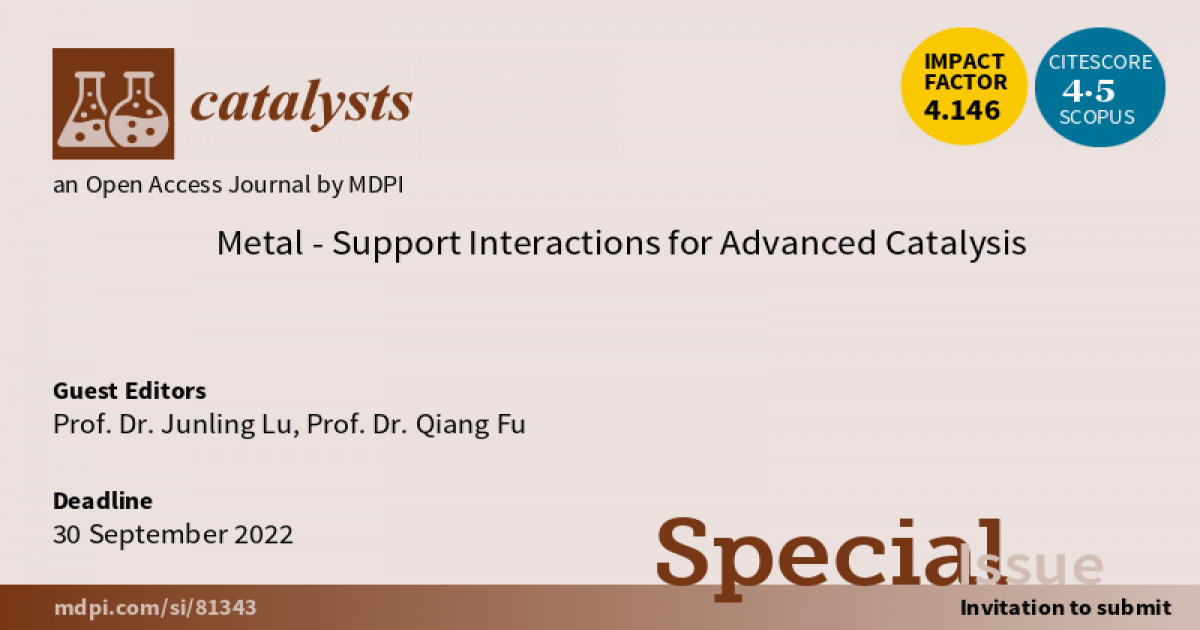Metal-Support Interactions for Advanced Catalysis
A special issue of Catalysts (ISSN 2073-4344). This special issue belongs to the section "Catalytic Materials".
Deadline for manuscript submissions: closed (30 September 2022) | Viewed by 16890

Special Issue Editors
Interests: supported metal catalyst; single atom catalyst; structure-activity relationship; atomic layer deposition; selective hydrogenation reactions; methane activation; CO2 utilization
Interests: surface science; heterogeneous catalysis; thin films; interface science
Special Issues, Collections and Topics in MDPI journals
Special Issue Information
Dear Colleagues,
Supported metal catalysts are an important category of heterogeneous catalysts and are widely applied in various industrial chemical reactions. Metal–support interactions play essential roles in the dispersion of metals with a high surface area and the stabilization of metal particles during catalysis. Such interactions could also have a substantial impact on the shape of the metal particles (e.g., two dimensional versus three dimensional ones), thus tuning catalytic performance remarkably. In the case of noble metals on reducible oxide, they could even cause migration of the oxide to the surface of metal particles after high-temperature reduction, which is called strong metal–support interaction (SMSI). Meanwhile, these interactions might also induce substantial electronic perturbations to metal particles. Such “electronic metal–support interactions” (EMSIs), rationalized in terms of charge transfer, were suggested to modulate the metal d-band centers, thus often leading to outstanding catalytic activity. Therefore, understanding metal–support interactions is essential for tuning the activity, selectivity and stability of oxide-supported metal catalysts.
This Special Issue is focused on, but not limited to, recent progress in characterization, understanding and application of metal–support interactions in heterogeneous catalysis.
Prof. Dr. Junling Lu
Prof. Dr. Qiang Fu
Guest Editors
Manuscript Submission Information
Manuscripts should be submitted online at www.mdpi.com by registering and logging in to this website. Once you are registered, click here to go to the submission form. Manuscripts can be submitted until the deadline. All submissions that pass pre-check are peer-reviewed. Accepted papers will be published continuously in the journal (as soon as accepted) and will be listed together on the special issue website. Research articles, review articles as well as short communications are invited. For planned papers, a title and short abstract (about 100 words) can be sent to the Editorial Office for announcement on this website.
Submitted manuscripts should not have been published previously, nor be under consideration for publication elsewhere (except conference proceedings papers). All manuscripts are thoroughly refereed through a single-blind peer-review process. A guide for authors and other relevant information for submission of manuscripts is available on the Instructions for Authors page. Catalysts is an international peer-reviewed open access monthly journal published by MDPI.
Please visit the Instructions for Authors page before submitting a manuscript. The Article Processing Charge (APC) for publication in this open access journal is 2200 CHF (Swiss Francs). Submitted papers should be well formatted and use good English. Authors may use MDPI's English editing service prior to publication or during author revisions.
Keywords
- Supported metal catalysts
- Single-atom catalyst
- Strong metal–support interactions
- Electronic metal−support interactions
- Metal–oxide interfaces
- Particle size effect
- Support effect
- Charge transfer
Benefits of Publishing in a Special Issue
- Ease of navigation: Grouping papers by topic helps scholars navigate broad scope journals more efficiently.
- Greater discoverability: Special Issues support the reach and impact of scientific research. Articles in Special Issues are more discoverable and cited more frequently.
- Expansion of research network: Special Issues facilitate connections among authors, fostering scientific collaborations.
- External promotion: Articles in Special Issues are often promoted through the journal's social media, increasing their visibility.
- e-Book format: Special Issues with more than 10 articles can be published as dedicated e-books, ensuring wide and rapid dissemination.
Further information on MDPI's Special Issue polices can be found here.






